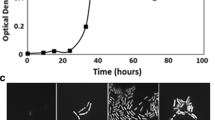Summary
The detection of bacteria using a thionine mediated microbial fuel cell was examined. On addition of bacteria to the anode compartment of a fuel cell, a rapid increase in the current output was observed. Both the total change in the steady state current (ΔmA) and the initial rate of change of current were proportional to the numbers of bacteria added. Regression analysis of plots of log10 ΔmA against log10 bacteria ml-1 (final concentration) upon the addition of E. coli K12, Lactococcus lactis, coliform sp. A1, Micrococcus sp. M3 but not Pseudomonas sp. P5 gave reasonable correlation coefficients. Determination of the rates of respiration and thionine reduction by E. coli indicated that the transfer of metabolic electrons from the bacteria to the mediator was reasonably efficient (approx. 50%). These results are discussed with respect to the potential application of this technique for the rapid estimation of the bacterial contamination of foods.
Similar content being viewed by others
References
Anon (1986): Biological Sciences-Themes. Science and Engineering Research Council, Swindon, England pp 16–17
Bennetto HP, Delaney GM, Mason JR, Roller SD, Stirling JL, Thurston CF (1986) The sucrose fuel cell: efficient biomass conversion using a microbial catalyst. Biotechnol Letts 7:699–704
Davis G, Hill HAO, Aston WJ, Higgins IJ, Turner APF (1983) Bioelectrochemical fuel cell and sensor based on a quinoprotein, alcohol dehydrogenase. Enz Microb Technol 5:383–388
Delaney GM, Bennetto HP, Mason JR, Roller SD, Stirling JL, Thurston CF (1984) Electron-transfer coupling in microbial fuel cells. 2. Performance of fuel cells containing selected microorganisms-mediator-substrate combinations. J Chem Tech Biotechnol 34B:13–27
Easter MC, Gibson DM (1985) Rapid and automated detection of Salmonella by electrical measurements. J Hygiene (Camb) 94:245–262
Firstenberg-Eden R, Eden G (1984) Impedance Microbiology. Research Studies Press Ltd, Letchworth
Jay JM (1986) Microbial spoilage indicators and metabolites. In: Foodborne microorganisms and their toxins: Developing methodology. Pierson MD, Stern NJ (ed), Marcel Dekker Inc, New York Basel, pp 219–240
LaRocco KA, Littel KJ, Pierson MD (1986) The Bioluminescent ATP assay for determining the microbial quality of foods. In: Foodborne microorganisms and their toxins: Developing methodology. Pierson MD, Stern NJ (ed), Marcel Dekker Inc, New York Basel, pp 145–174
Lück H (1982) Reduction tests for determination of the bacteriological quality of raw milk. Kieler Milchwirtsch Forschung 34:108–116
Nishikawa S, Sakai S, Karube I, Matsunaga T, Suzuki S (1982) Dye-coupled electrode systems for the rapid determination of cell populations in polluted water. Appl Environ Micro 43:814–818
Pettipher GL (1983) The direct epifluorescent filter technique for the rapid enumeration of microorganisms. Research Studies Press Ltd, Letchworth
Plotkin EV, Higgins IJ, Hill HAO (1981) Methanol dehydrogenase bioelectrochemical cell and alcohol detector. Biotechnol Letts 3:187–192
Roller SD, Bennetto HP, Delaney GM, Mason JR, Stirling JL, Thurston CF (1984) Electron-transfer coupling in microbial fuel cells. 1. Comparison of Redox-mediator reduction rates and respiratory rates of bacteria. J Chem Tech Biotechnol 34B:3–12
Sharpe AN (1979) An alternative approach to food microbiology for the future. Food Technol (March):71–74
Stannard CJ, Wood JM (1983) The rapid estimation of microbial contamination of raw meat by measurement of adenosine triphosphate (ATP). J Appl Bact 55:429–438
Tanaka K, Vega CA, Tamaushi R (1983) 612bis-Thionine and Ferric Chelate compounds as coupled mediators in microbial fuel cells. Bioelectrochemistry and Bioenergetics 11:289–297
Thurston CF, Bennetto HP, Delaney GM, Mason JR, Roller SD, Stirling JL (1985) Glucose metabolism in a Microbial Fuel Cell. Stoichiometry of product formation in a thionine-mediated Proteus vulgaris fuel cell and its relation to Coulombic yields. J Gen Microbiol 131:1393–1401
Turner APF, Ramsay G, Higgins IJ (1983) Applications of electron transfer between biological systems and electrodes. Biochem Soc Trans 11:445–448
Wilson GS (1935) The bacteriological grading of milk. Medical Research Council HMSO, London
Author information
Authors and Affiliations
Rights and permissions
About this article
Cite this article
Patchett, R.A., Kelly, A.F. & Kroll, R.G. Use of a microbial fuel cell for the rapid enumeration of bacteria. Appl Microbiol Biotechnol 28, 26–31 (1988). https://doi.org/10.1007/BF00250492
Received:
Accepted:
Issue Date:
DOI: https://doi.org/10.1007/BF00250492




